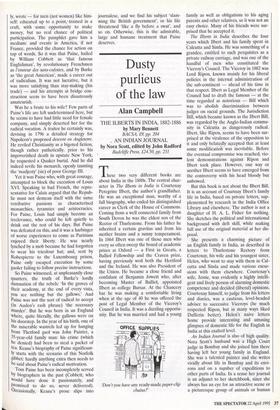Dusty purlieus of the law
Alan Campbell
THE ILBERTS IN INDIA, 1882-1886 by Mary Bennett BACSA, 19, pp. 204 . AN INDIAN JOURNAL by Nora Scott, edited by John Radford Radcliffe Press, 424.50, pp. 231 • These two very different books are about India in the 1880s. The central char- acter in The Ilberts in India is Courtenay Peregrine Ilbert, the author's grandfather. He was an exceptional man, worthy of a full biography, who ended his distinguished career as Clerk of the House of Commons. Coming from a well connected family from South Devon he was the eldest son of the Rector of Thurlestone. From his father he inherited a certain gravitas and from his mother brains and a sunny temperament. In 1864 Ilbert was one of those men who every so often sweep the board of academic prizes at Oxford — a First in Greats, a Balliol Fellowship and the Craven prize, having previously wotI both the Hertford and the Ireland. He was also President of the Union. He became a close friend and confidant of Benjamin Jowett who, after becoming Master of Balliol, appointed Ilbert as college Bursar. At the Chancery bar he was making a comfortable living when at the age of 40 he was offered the post of Legal Member of the Viceroy's Council in India. It was a dazzling opportu- nity. But he was married and had a young `Don't you have any ready-made paper-clip chains?' family as well as obligations to his aging parents and other relatives, so it was not an easy choice. Many of his friends were sur- prised that he accepted it.
The Ilberts in India describes the four years which Ilbert and his family spent in Calcutta and Simla. He was something of a grandee, entitled to such perquisites as a private railway carriage, and was one of the handful of men who constituted the Viceroy's Council. The Viceroy in 1882 was Lord Ripon, known mainly for his liberal policies in the internal administration of the sub-continent — ahead of his time in that respect. Ilbert as Legal Member of the Council had to draft the famous — at the time regarded as notorious — Bill which was to abolish discrimination between judges on racial grounds. The Jurisdiction Bill, which became known as the Ilbert Bill, was regarded by the Anglo-Indian commu- nity in Calcutta as dangerously radical. Ilbert, like Ripon, seems to have been sur- prised at the virulence of the opposition to it and only belatedly accepted that at least some modificatiol was inevitable. Before the eventual compromise was reached, vio- lent demonstrations against Ripon and Ilbert took place. However, one way or another Ilbert seems to have emerged from the controversy with his head bloody but unbowed.
But this book is not about the Ilbert Bill. It is an account of Courtnay Ilbert's family life in India, based on private letters, sup- plemented by research in the India Office Library and elsewhere. The author is not a daughter of H. A. L. Fisher for nothing. She sketches the political and international background with deft skill, while making full use of the original material at her dis- posal.
She presents a charming picture of an English family in India, as described in letters to Thurlestone Rectory from Courtenay, his wife and his youngest sister, Helen, who went to stay with them in Cal- cutta and Simla and made various excur- sions with them elsewhere. Courtenay's wife, Jessie, was evidently a highly intelli- gent and lively person of alarming domestic competence and decided (liberal) opinions. Courtenay himself, to judge from his letters and diaries, was a cautious, level-headed adviser to successive Viceroys (he much respected Ripon, but in many ways liked Dufferin better). Helen's naive letters home provide interesting and amusing glimpses of domestic life for the English in India at this exalted level.
An Indian Journal is also of high quality. Nora Scott's husband was a High Court judge in Bombay and she joined him there having left her young family in England. She was a talented painter and she writes vividly about life in Bombay and its envi- rons and on a number of expeditions to other parts of India. In a sense her journal is an adjunct to her sketchbook, since she always has an eye for an attractive scene or a picturesque group of animals or human beings. She has no great interest in political matters but her observation of manners is perceptive, while she evidently established easy social relations with many Indians.
Both books are of attractive appearance, the Indian Journal being the more expen- sively produced and illustrated.



























































 Previous page
Previous page